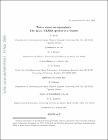| dc.contributor.author | HARPER, GRAHAM | |
| dc.date.accessioned | 2009-09-22T12:13:01Z | |
| dc.date.available | 2009-09-22T12:13:01Z | |
| dc.date.issued | 2006 | |
| dc.date.submitted | 2006 | en |
| dc.identifier.citation | Ryde, N., Richter, M. J., Harper, G. M., Eriksson, K., & Lambert, D. L. `Water vapor on supergiants. The 12 micron TEXES spectra of ? Cephei, Astrophysical Journal in 645, (1), 2006, pp 652-658 | en |
| dc.identifier.other | Y | |
| dc.identifier.other | Y | en |
| dc.identifier.uri | http://hdl.handle.net/2262/33129 | |
| dc.description | PUBLISHED | en |
| dc.description.abstract | Several recent papers have argued for warm, semidetached, molecular layers surrounding red giant and supergiant stars, a concept known as a MOLsphere. Spectroscopic and interferometric analyses have often corroborated this general picture. Here we present high-resolution spectroscopic data of pure rotational lines of water vapor at 12 ?m for the supergiant ? Cep. This star has often been used to test the concept of molecular layers around supergiants. Given the prediction of an isothermal, optically thick water vapor layer in local thermodynamic equilibrium around the star (MOLsphere), we expected the 12 ?m lines to be in emission or at least in absorption but filled in by emission from the molecular layer around the star. Our data, however, show the contrary; we find definite absorption. Thus, our data do not easily fit into the suggested isothermal MOLsphere scenario. The 12 ?m lines, therefore, put new, strong constraints on the MOLsphere concept and on the nature of water seen in signatures across the spectra of early M supergiants. We also find that the absorption is even stronger than that calculated from a standard, spherically symmetric model photosphere without any surrounding layers. A cool model photosphere, representing cool outer layers, is, however, able to reproduce the lines, but this model does not account for water vapor emission at 6 ?m. Thus, a unified model for water vapor on ? Cep appears to be lacking. It does seem necessary to model the underlying photospheres of these supergiants in their whole complexity. The strong water vapor lines clearly reveal inadequacies of classical model atmospheres. | en |
| dc.description.sponsorship | We would like to thank Bengt Gustafsson and John H. Lacy for fruitful suggestions
and enlightening discussions. We acknowledge the support we received from John H. Lacy,
Daniel T. Jaffe, and Qingfeng Zhu of the TEXES team during the observations of ? Cep. We
are grateful for the help of the irtf staff. This work was supported in part by the Swedish
Research Councils (vr and stint), the Robert A. Welch Foundation of Houston, Texas,
nsf grant AST-0307497 and NASA grant NNG04GG92G. Observations with TEXES were
supported by NSF grant AST-0205518. | en |
| dc.format.extent | 652-658 | en |
| dc.format.extent | 890481 bytes | |
| dc.format.mimetype | application/pdf | |
| dc.language.iso | en | en |
| dc.publisher | American Astronomical Society | en |
| dc.relation.ispartofseries | Astrophysical Journal | en |
| dc.relation.ispartofseries | 645 | en |
| dc.relation.ispartofseries | 1 | en |
| dc.rights | Y | en |
| dc.subject | infrared: stars; stars: atmospheres; stars: individual (? Cephei) | en |
| dc.title | Water vapor on supergiants. The 12 micron TEXES spectra of ? Cephei | en |
| dc.type | Journal Article | en |
| dc.contributor.sponsor | NASA | |
| dc.type.supercollection | scholarly_publications | en |
| dc.type.supercollection | refereed_publications | en |
| dc.identifier.peoplefinderurl | http://people.tcd.ie/harperg | |
| dc.identifier.rssuri | http://dx.doi.org/10.1086/504287 | |




